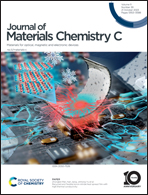Yellow phosphor based on zero-dimensional antimony halide for white light-emitting diodes†
Abstract
Lead-free low-dimensional organic–inorganic hybrid metal halides (OIMHs) have been widely used in solid-state lighting (SSL) on account of their excellent photoluminescent properties and stability. Herein, we synthesized a new zero-dimensional (0D) antimony-based metal halide of (NII)2SbCl5 (NII+ = C12H17NH+, N-(2,4,6-trimethylphenyl) isopropylimide Schiff's bases), which shows a broadband yellow emission peaking at 610 nm with a photoluminescence quantum yield of over ∼88% under 365 nm excitation, and its dual peak emission under excitation of 300–340 nm is ascribed to the radiative recombination from singlet and triplet self-trapped excitons (STEs) in [SbCl5]2−. A white light emitting diode (WLED) was assembled with a phosphor mixture in which commercial green and blue phosphors were mixed with the (NII)2SbCl5 phosphor, and it exhibits perfect white-light CIE coordinates of (0.32, 0.34), with a correlated color temperature (CCT) of 6071 K and a color rendering index (CRI) of 81.58. This indicates that 0D (NII)2SbCl5 is a promising yellow phosphor material for SSL.



 Please wait while we load your content...
Please wait while we load your content...